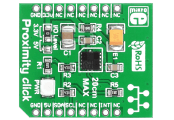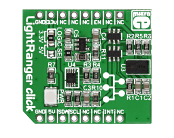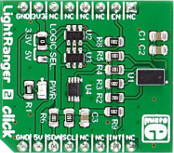|
|
| |
|
 | Search: |
|
|
 |

|
|
Proximity 3 click is an intelligent proximity and light sensing device, which features the VCNL4200 sensor from Vishay - high sensitivity long distance proximity sensor (PS), ambient light sensor (ALS) and 940 nm IRED, all in one small package.
With its smart sensing and light conditioning properties, the Proximity 3 click can be used in a wide range of applications: adjusting the brightness of the TFT screen depending on ambient light, turning off the TFT background light if it is covered, very accurate lux meters, reliable security sensors and so on.
|
|
|
|
|
 |

|
|
Proximity click features a VCNL4010 proximity and ambient light sensor. It combines an infrared emitter and PIN photodiode for proximity measurement with a range of up to 20cm. The VCNL4010 has a 16bit resolution which ensures excellent cross talk immunity. It can also be used as an ambient light sensor. Proximity click communicates with the target board microcontroller via mikroBUS I2C (SDA, SCL) and INT lines. The board is designed to use 3.3V power supply and 3.3V or 5V I/O voltage levels. |
|
|
|
 |

|
|
Proximity 2 click features the MAX44000, an IC that integrates an ambient light as well as a proximity sensor. The chip consists of an array of photodiodes that convert light into current, which the internal circuitry then converts into a digital value. The light sensor has a dynamic range of 0.03 to 65.535 lux. The IR proximity detector is matched with an integrated IR LED driver (for the onboard high power infrared LED). Proximity 2 click communicates with the target board microcontroller through mikroBUS I2C (SCL, SDA), and INT lines. It is designed to use a 3.3V power supply only. |
|
|
|
 |

|
|
LightRanger click is a proximity sensor carrying ST's VL6180X IC. This chip is based on ST's patented FlightSense technology: the sensor - consisting of an IR emitter, ambient light sensor, and range sensor - calculates distance by measuring the time it takes for a photon to travel to the nearest object and back (Time of Flight). In contrast to conventional IR proximity sensors which derive distance by measuring the amount of light reflected, VL618OX works with all objects, regardless of their color or reflectivity. LightRanger click communicates with the target board MCU through mikroBUS I2C pins (SCL, SDA), with additional interrupt (INT) and enable (EN, in place of default mikroBUS CS pin). |
|
|
|
 |

|
|
LightRanger 2 click carries VL53L0X IC from STMicroelectronics, the word's smallest Time-of-Flight ranging and gesture detector sensor. The click is designed to run on either 3.3V or 5V power supply. LightRanger 2 click communicates with the target microcontroller over I2C interface and the following pins on the mikroBUS™ line: RST, INT. |
|
|
|
 |

|
|
IR reflect click carries a GP2S700HCP reflective photointerrupter and an onboard potentiometer. On this type of photointerrupter the infrared emitter and receiver are facing the same direction; the infrared beam from the emitter gets bounced back to the receiver when an object is placed within the detecting range of the sensor. IR reflect click communicates with the target board microcontroller through mikroBUS AN and INT pins (an onboard potentiometer sets the Interrupt threshold). It’s designed to use either a 3.3V or 5V power supply. |
|
|
|
 |

|
|
IR distance click carries Sharp's GP2Y0A60SZ0F distance measuring sensor. The sensor module comprises an integrated PSD (position sensitive detector), an infrared LED and a signal processing circuit. The measuring range is between 10 and 150 cm. The sensor is not easily influenced by the reflectivity of the object, but it's important to keep the lens clean. The click board outputs an analog voltage corresponding to the distance of the object (through the mikroBUS AN pin). An Enable (EN) pin is also utilized. The board is designed to use either a 3.3V or a 5V power supply. |
|
|
|
 |
|
|

